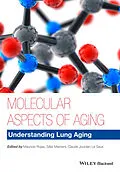Molecular Aspects of Aging: Understanding Lung Aging covers recent research in the mechanisms that contribute to cellular senescence. Covering universal themes in aging, such as the exhaustion of stem cells and subsequent loss of the regenerative refueling of organs as well as immunosenescence, this text illuminates new directions for research not yet explored in the still poorly investigated area of molecular mechanisms of lung aging. The molecular nature of general aging processes is explored with targeted coverage on how to analyze lung aging through experimental approaches.
Autorentext
Dr. Mauricio Rojas is an Assistant Professor in the Division of Pulmonary, Allergy and Critical Care Medicine, Department of Medicine, University of Pittsburgh.
Silke Meiners, PhD is a Research Group Leader from the Comprehensive Pneumology Center in Munich.
Claude Jourdan Le Saux, PhD is an Assistant Professor in the Department of Medicine Division of Cardiology/Pulmonary and Critical Care, University of Texas Health Science Center at San Antonio, San Antonio, Texas, as well as a faculty member of the Barshop Institute for Longevity and Aging Studies Nathan Shock Aging Center of Excellence and Department of Cellular and Structural Biology.
Inhalt
Contributors xi
Preface xiii
1 The Demography of Aging 1
David E. Bloom and Sinead Shannon
1.1 Introduction 1
1.2 Demographic trends 1
1.2.1 Fertility rates 2
1.2.2 Mortality rates and life expectancy 2
1.2.3 Proportion of older people 3
1.3 Impact of aging 4
1.3.1 Noncommunicable disease trends 4
1.3.2 Risk factors 5
1.3.3 Impact of NCDs on health and disability 6
1.3.4 Increase in multimorbidities 7
1.3.5 Impact on expenditure 7
1.4 Policy responses 8
1.4.1 Preventing and managing NCDs 8
1.4.2 Promoting exercise 9
1.4.3 Monitoring health-risk behaviors (and chronic health conditions) 9
1.5 Conclusion 9
References 10
2 The Omics of Aging: Insights from Genomes upon Stress 13
Ismene Karakasilioti, Anna Ioannidou, and George A. Garinis
2.1 Introduction 13
2.2 Safeguarding the nuclear genome 14
2.3 NER progerias and their connection to lifespan regulatory mechanisms 15
2.4 Triggering a survival response in the absence of a DNA repair defect 16
2.5 The omics connection between progeria and longevity 19
2.6 Triggering of systemic versus cell-autonomous features of the survival response 20
2.7 The omics connection between NER progeria, transcription, and longevity 21
2.8 Future perspectives 22
References 22
3 Protein Quality Control Coming of Age 27
Silke Meiners
3.1 Introduction 27
3.2 The aging molecular chaperone network 29
3.3 Protein degradation pathways in aging 30
3.3.1 Lysosomal autophagy pathway 30
3.3.2 Ubiquitinproteasome system 32
3.4 Compartment-specific protein quality control 34
3.4.1 The aging ER stress response 34
3.5 Conclusion 35
References 35
4 Telomerase Function in Aging 41
Rodrigo T. Calado
4.1 Telomeres 41
4.2 Telomerase 43
4.3 Telomeres and human disease 45
4.3.1 Telomere dysfunction in the lungs 46
4.4 Telomeres biology, aging, and longevity 47
4.5 Conclusion 48
References 48
5 The Cellular Senescence Program 53
Pooja Shivshankar and Claude Jourdan Le Saux
5.1 Cellular senescence and evidence of senescence in a cell 53
5.1.1 Characteristics of senescent cells and the inflammatory microenvironment 53
5.1.2 Detection of senescent cells in vitro and in vivo 54
5.2 Conditions associated with cellular senescence 55
5.2.1 Oxidative stress 55
5.2.2 DNA damage 55
5.2.3 Cell cycle arrest and senescence 56
5.3 Mechanisms/pathways of senescence induction 56
5.3.1 The p53/p21 pathway 56
5.3.2 The p16/pRB pathway 57
5.3.3 Convergence/coactivation of p53/p21 and p16/pRB pathways 57
5.3.4 Induction of senescence via molecular signaling 57
5.4 Cellular senescence in aging and age-related diseases of the lungs 58
5.4.1 Normal aging 59
5.4.2 Pneumonia 59
5.4.3 Chronic obstructive pulmonary disease 60
5.4.4 Idiopathic pulmonary fibrosis 60
5.5 Conclusion 61
References 61
6 Signaling Networks Controlling Cellular Senescence 67
Leena P. Desai, Yan Y. Sanders, and Victor J. Thannickal
6.1 Introduction 67
6.2 Classification of cellular senescence 69
6.2.1 Intrinsic pathway 69
6.2.2 Extrinsic pathway 69
6.2.3 Reversibility of cellular senescence 70
6.3 Cross talk of signaling pathways 70
6.3.1 Protein kinases 70
6.3.2 Metabolic pathways 71
6.3.3 Mitochondria and reactive oxygen species 71
6.3.4 Integrin and focal adhesion signaling 72
